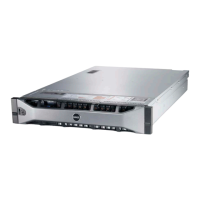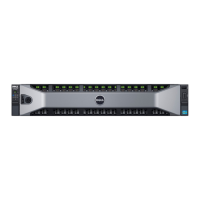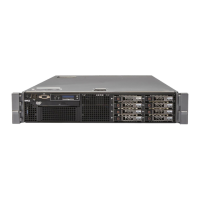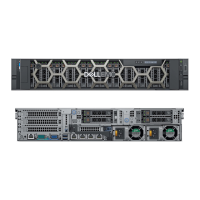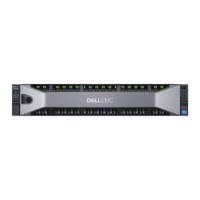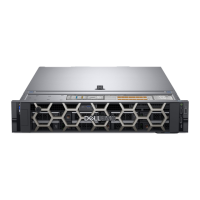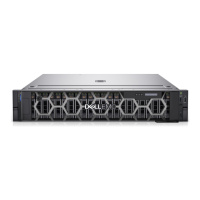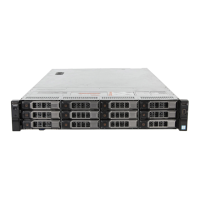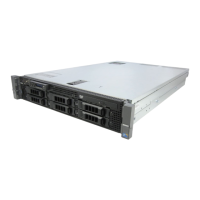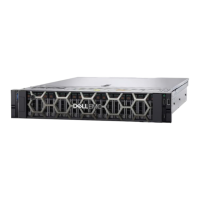Do you have a question about the Dell PowerEdge R720xd and is the answer not in the manual?
Details front panel components, buttons, and indicators.
Describes the LCD panel and its navigation buttons.
Explains front panel diagnostic indicators and their meanings.
Details components and indicators on the system's back panel.
Explains the indicator codes for the Network Interface Card.
Describes the indicator codes for power supply status.
Provides steps to access the system setup utility.
Outlines the main categories of settings in System Setup.
Describes the options within the System BIOS configuration.
Explains memory-related settings and configurations.
Covers processor configuration options and details.
Options for configuring system boot mode and sequence.
Settings for integrated hardware components like RAID and USB.
Options for system password and security settings.
Details on creating and managing system and setup passwords.
Steps to access the UEFI Boot Manager.
Information on supported memory types and installation.
Information on connecting and installing hard drives.
Steps to safely remove and install a hot-swap hard drive.
Procedure for removing and installing an optical drive.
Information and procedures for cooling fans.
Guidelines for installing expansion cards and risers.
Step-by-step guide to installing a GPU card.
Step-by-step guide to installing a processor.
Information and procedures for AC and DC power supplies.
Procedure for replacing the system battery.
Procedure to remove the hard-drive backplane.
Steps to resolve system startup issues.
Steps to troubleshoot USB device connectivity.
Steps to troubleshoot network interface card issues.
Procedure for handling a system exposed to liquid.
Steps to troubleshoot system battery issues.
Steps to troubleshoot power supply problems.
Steps to troubleshoot hard drive failures.
Steps to troubleshoot processor issues.
Overview of the embedded diagnostic system (ePSA).
Steps to launch the embedded diagnostics program.
Details jumper settings on the system board.
Identifies and describes system board connectors.
Procedure to disable system passwords using jumpers.
Specifications for the system's processor.
Specifications for system memory (architecture, capacity).
Specifications for hard drive systems and configurations.
Information on operating temperatures and de-rating.
Brief text messages displayed on the LCD.
Explains system messages and their formats.
Information on how to contact Dell support.
Details front panel components, buttons, and indicators.
Describes the LCD panel and its navigation buttons.
Explains front panel diagnostic indicators and their meanings.
Details components and indicators on the system's back panel.
Explains the indicator codes for the Network Interface Card.
Describes the indicator codes for power supply status.
Provides steps to access the system setup utility.
Outlines the main categories of settings in System Setup.
Describes the options within the System BIOS configuration.
Explains memory-related settings and configurations.
Covers processor configuration options and details.
Options for configuring system boot mode and sequence.
Settings for integrated hardware components like RAID and USB.
Options for system password and security settings.
Details on creating and managing system and setup passwords.
Steps to access the UEFI Boot Manager.
Information on supported memory types and installation.
Information on connecting and installing hard drives.
Steps to safely remove and install a hot-swap hard drive.
Procedure for removing and installing an optical drive.
Information and procedures for cooling fans.
Guidelines for installing expansion cards and risers.
Step-by-step guide to installing a GPU card.
Step-by-step guide to installing a processor.
Information and procedures for AC and DC power supplies.
Procedure for replacing the system battery.
Procedure to remove the hard-drive backplane.
Steps to resolve system startup issues.
Steps to troubleshoot USB device connectivity.
Steps to troubleshoot network interface card issues.
Procedure for handling a system exposed to liquid.
Steps to troubleshoot system battery issues.
Steps to troubleshoot power supply problems.
Steps to troubleshoot hard drive failures.
Steps to troubleshoot processor issues.
Overview of the embedded diagnostic system (ePSA).
Steps to launch the embedded diagnostics program.
Details jumper settings on the system board.
Identifies and describes system board connectors.
Procedure to disable system passwords using jumpers.
Specifications for the system's processor.
Specifications for system memory (architecture, capacity).
Specifications for hard drive systems and configurations.
Information on operating temperatures and de-rating.
Brief text messages displayed on the LCD.
Explains system messages and their formats.
Information on how to contact Dell support.
| Tcase | 70 °C |
|---|---|
| Bus type | QPI |
| Stepping | M1 |
| FSB Parity | No |
| Scalability | 2S |
| Processor cache | 10 MB |
| Processor cores | 4 |
| Processor model | E5-2609 |
| System bus rate | 6.4 GT/s |
| Processor series | Intel Xeon E5-2600 |
| Processor socket | LGA 2011 (Socket R) |
| Processor codename | Sandy Bridge EP |
| Motherboard chipset | Intel C600 |
| Number of QPI links | 2 |
| Processor frequency | 2.4 GHz |
| Processor cache type | Smart Cache |
| Processor manufacturer | Intel |
| Processor package size | 52.5 x 45.0 mm |
| Processor front side bus | - MHz |
| Processor boost frequency | 2.50 GHz |
| Processor operating modes | 64-bit |
| ECC supported by processor | Yes |
| Graphics & IMC lithography | 32 nm |
| PCI Express configurations | x4, x8, x16 |
| Supported instruction sets | AVX |
| Thermal Design Power (TDP) | 80 W |
| Number of processors installed | 1 |
| CPU multiplier (bus/core ratio) | 24 |
| Physical Address Extension (PAE) | 46 bit |
| Maximum number of PCI Express lanes | 40 |
| Memory types supported by processor | DDR3-SDRAM |
| Memory channels supported by processor | Quad |
| Memory clock speeds supported by processor | 800, 1066 MHz |
| Memory bandwidth supported by processor (max) | 34.1 GB/s |
| Maximum internal memory supported by processor | 750 GB |
| HDD size | 3.5 \ |
| Optical drive type | DVD-RW |
| Total storage capacity | - GB |
| Maximum storage capacity | 32 TB |
| Number of HDDs installed | - |
| Number of HDDs supported | 14 |
| Memory slots | 24x DIMM |
| Internal memory | 8 GB |
| Memory clock speed | 1333 MHz |
| Maximum internal memory | 768 GB |
| Cabling technology | 10/100/1000Base-T(X) |
| USB 2.0 ports quantity | 3 |
| PCI Express slots version | 3.0 |
| Power supply | 1100 W |
| Compatible operating systems | Microsoft Windows Server 2012 \\r Microsoft Windows Server 2012 Essentials\\r Microsoft Windows Server 2008 R2 \\r Novell SUSE Linux Enterprise Server\\r Red Hat Enterprise Linux |
| Sustainability certificates | ENERGY STAR |
| Chassis type | Rack (2U) |
| Processor ARK ID | 64588 |
| Intel Secure Key Technology version | 1.00 |
| Intel Identity Protection Technology version | 0.00 |
| Width | - mm |
|---|
